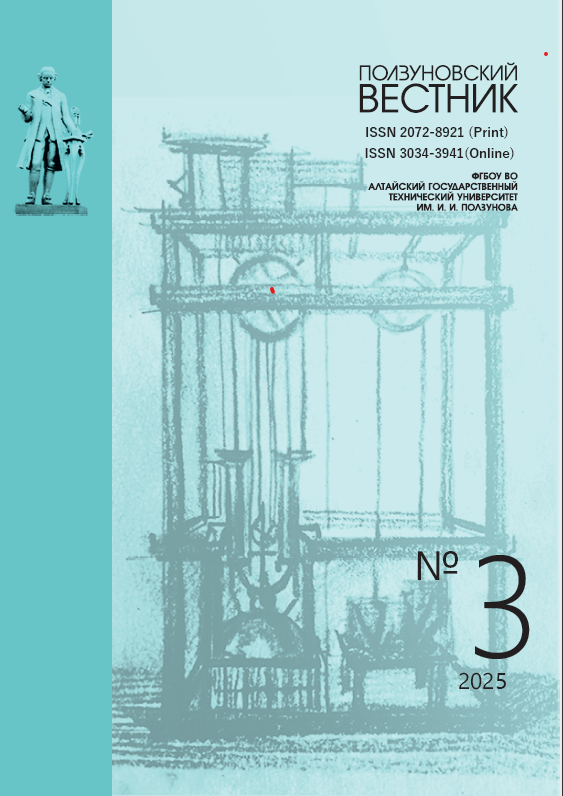MODIFICATION OF PEA FLOUR PROTEINS USING A NEW STRAIN OF LACTIC ACID BACTERIA
DZQNIP
DOI:
https://doi.org/10.25712/ASTU.2072-8921.2025.03.012Keywords:
pea flour, lactobacilli, fermentation, protein, modification, functional properties, amino acid composition, digestibility, biological valueAbstract
To expand the range of protein products from peas with high biological value and functional and technological properties, research in the field of lactofermentation of plant materials is promising. The aim of the work is to study changes in the functional and technological properties and biological value of proteins in pea flour fermented with a new strain of lactic acid bacteria Lacticaseibacillus rhamnosus KM-1. After modification of flour for 24 and 48 hours, an increase in ash elements by 61.1–72.5% was found, which is explained by the accumulation of sodium lactate during the fermentation process. Fermented flour was digested in vitro better than the control by 10.77–11.66%, with increased water-binding (by 16.3–22.2%), foaming (by 2.15–2.22 times), fat-binding (by 2.87–3.43 times) capacities, acid-soluble (by 28.57–96.55%), alcohol-soluble (by 12.2–15.8 times) and salt-soluble (by 8.09–18.00 times) fractions of proteins, content of aromatic amino acids – phenylalanine (by 16.7–22.3%) and tyrosine (by 53.0–56.8%), as well as biological value of protein (by 11.66–12.04%). It was noted that in pea flour fermented for 48 hours, compared to one-day modification, the content of lysine, arginine, salt- and alcohol-soluble fractions of proteins decreased, and the indices of functional and technological properties, digestibility and biological value of proteins practically did not change, which indicates the inexpediency of increasing the duration of fermentation by lactobacilli for more than one day. Samples of fermented flour had a taste and smell characteristic of lactic acid bacteria with a slight pea flavor, and a dark cream color formed as a result of heat treatment of pea extract during the preparation of the nutrient medium before sowing lactobacilli. Given the high amount of protein, increased indices of binding water and fat and forming foam, fermented pea flour obtained using the new strain of lactic acid bacteria, it is advisable to recommend for use as a protein additive in the manufacture of "vegetable meat" type products and confectionery.
References
Рыбакова Д.Э. Горох. Посевные площади, валовые сборы и урожайность в 2023 году // Экспертно-аналитический центр агробизнеса «АБ-Центр». URL: https://abcentre.ru/news/goroh-posevnye-ploschadi-valovye-sbory-i-urozhaynost-v-2023-godu?ysclid=m10oyy92kr454619867 (дата обращения: 15.10.2024)
Питательная ценность сортов сои, гороха, фасоли и содержание в них антипитательных веществ / В.И. Возиян, М.Г. Таран, М.Д. Якобуца, Л.П. Авадэний // Зернобобовые и крупяные культу-ры. 2013. Т. 1(5). С. 26–29.
Webber J. How Many CO2 Emissions Does The Meat Industry Actually Produce? // Plant Based News. URL: https://plantbasednews.org/opinion/the-long-read/emissions-meat-industry/ (дата обраще-ния: 15.10.2024)
Куликов Д.С., Арюзина М.А. Биокаталиче-ский и биосинтетический способы получения бел-ковых концентратов из гороха и нута // Пищевые системы. 2021. Т. 4. № 3S. С. 160-167. DOI: 10.21323/2618-9771-2021-4-3S-160-167
Куликов Д.С., Аксёнова Л.М., Самойлова А.М. Функционально-технологические свойства белковых продуктов из зернобобовых культур и их модификация под влиянием различных факторов. Часть 1 // Пищевая промышленность. 2024. № 3. С. 20-25. DOI: 10.52653/PPI.2024.3.3.004
The Effect of Various Domestically Produced Proteolytic Enzyme Preparations on the Organoleptic Properties of Pea Protein Isolates / I.V. Kravchenko [et al.] // Applied Biochemistry and Microbiology. 2024. V. 60. N. 4. P. 656-662. DOI: 10.1134/S0003683824604335
Куликов Д.С., Королев А.А. Функционально-технологические свойства белковых продуктов из зернобобовых культур и их модификация под вли-янием различных факторов. Часть 2 // Пищевая промышленность. 2024. № 8. С. 35-44. DOI: 10.52653/PPI.2024.8.8.007
Enzymatic modification of plant proteins for improved functional and bioactive properties / O.O. Olatunde [et al.] // Food and Bioprocess Technology. 2023. V. 16. P. 1216-1234. DOI: 10.1007/s11947-022-02971-5
Physicochemical property changes and aroma differences of fermented yellow pea flours: role of Lactobacilli and fermentation time / C. Li [et al.] // Food & Function. 2021. V. 12. N. 15. P. 6950-6963. DOI: 10.1039/d1fo00608h
Sensory improvement of a pea protein-based product using microbial co-cultures of lactic acid bacteria and yeasts / C. El Youssef [et al.] // Foods. 2020. V. 9. N. 3. P. 349. DOI: 10.3390/foods9030349
Апьянцева Ю.В., Борисова И.И., Баранен-ко Д.А. Обзор технологий выделения белка из нута // Ползуновский вестник. 2024. № 2. С. 27-36. DOI: 10.25712/ASTU.2072-8921.2024.02.004
Sensory profile, functional properties and molecular weight distribution of fermented pea protein isolate / V. García Arteaga [et al]. // Current research in food science. 2020. V. 4. P. 1–10. DOI: 10.1016/j.crfs.2020.12.001
Physicochemical properties and volatile components of pea flour fermented by Lactobacillus rhamnosus L08 / M. Pei [et al.] // Food Bioscience. 2022. V. 46. P. 101590. DOI: 10.1016/j.fbio.2022.101590
Синельников А.В., Уланова Р.В., Канапац-кий Т.А. Разработка технологии получения лакто-ферментированных продуктов на основе расти-тельного материала // Пищевая промышленность. 2024. № 8. С. 75-80. DOI:10.52653/PPI.2024.8.8.014
Куликов Д.С. Комплексная биотехнологи-ческая переработка гороховой муки с получением белковых концентратов // Диссертация на соиска-ние ученой степени кандидата технических наук. 2023. 158 с.
Колпакова В.В., Нечаев А.П. Белок из пшеничных отрубей. Функциональные свойства белковой муки: растворимость и водосвязываю-щая способность // Известия ВУЗов. Пищевая технология. 1995. Т. 1–2. С. 31–33.
Колпакова В.В., Нечаев А.П. Белок из пшеничных отрубей. Функциональные свойства белковой муки: эмульгирующие и пенообразующие свойства // Известия ВУЗов. Пищевая технология. 1995. Т. 1–2. С. 34–37.
FAO Dietary protein quality evaluation in human nutrition: Report of an
FAO Expert Consultation 31 March-2 April, 2011, Auckland, New Zealand // Food
and agriculture organization of the united nations. Rome. 2013. ISSN 0254-4725
Покровский А.А., Ертанов И.Д. Атакуе-мость белков пищевых продуктов // Вопросы пита-ния. 1965. № 3. С. 38-44.
Roberts E.O., Otunola E.T., Iwakun B.T. An evaluation of some quality parameters of a laboratory-prepared fermented groundnut milk // European Food Research and Technology. 2004. V. 218. P. 452-455.
Зачем в продукты добавляют Е325: лактат натрия // Материалы испытательной лаборатории «VestaLab». URL: https://testslab.ru/stati/zachem-v-produkty-dobavlyayut-e325-laktat-natriya/ (дата обращения: 15.10.2024)
Effect of Different Classes of Proteases on the Techno-Functional Properties of Pea Protein Iso-lates / I.V. Kravchenko [et al.] // Applied Biochemistry and Microbiology. 2024. V. 60. P. 106–117. DOI: 10.1134/S0003683824010083
Downloads
Published
How to Cite
Issue
Section
License
Copyright (c) 2025 Denis S. Kulikov, Ruzalia V. Ulanova, Alexey A. Korolev, Alexey V. Sinelnikov, Zoya I. Kalugina

This work is licensed under a Creative Commons Attribution 4.0 International License.















 .
. This work is licensed under a
This work is licensed under a 
